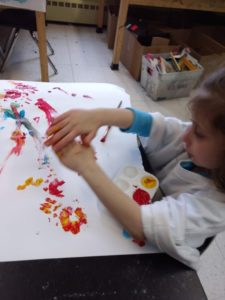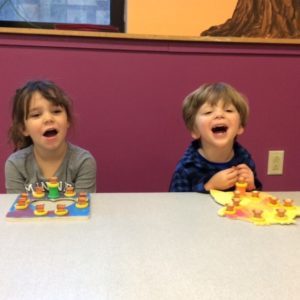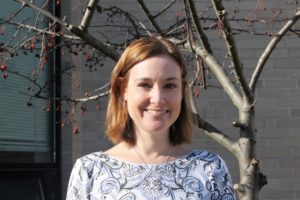Presenters from some of the various STEAM Splash workshops discuss their activities in this in-depth look at STEAM Splash days.
Presenters from some of the various STEAM Splash workshops discuss their activities in this in-depth look at STEAM Splash days.
 Young children love the immediate satisfaction of painting. Mixing colors is a magic and instant alchemy that has enthralled our Pre-K students for the past few weeks in art. Mr. Mirsky challenged the children to “invent” as many new colors as they could. With this prompting, children learned the basics of color theory and improved fine motor control, but they were also given the opportunity to create something the world has never seen before. That’s the sense of discovery we love to encourage in our art room!
Young children love the immediate satisfaction of painting. Mixing colors is a magic and instant alchemy that has enthralled our Pre-K students for the past few weeks in art. Mr. Mirsky challenged the children to “invent” as many new colors as they could. With this prompting, children learned the basics of color theory and improved fine motor control, but they were also given the opportunity to create something the world has never seen before. That’s the sense of discovery we love to encourage in our art room!
 Pre-K students have been very busy learning about and celebrating Hanukkah. After decorating their classroom, they learned the Hanukkah story as well as many songs in both Hebrew and English. Students created their very own Hanukkiyot (Hanukkah Menorahs) and were excited to bring them home to light during the holiday.
Pre-K students have been very busy learning about and celebrating Hanukkah. After decorating their classroom, they learned the Hanukkah story as well as many songs in both Hebrew and English. Students created their very own Hanukkiyot (Hanukkah Menorahs) and were excited to bring them home to light during the holiday.
Expanding upon some of the themes of the holiday (oil, light and darkness), the class did experiments using oil and water and learned about people who are visually impaired. Children even learned about the Braille alphabet, wrote their names in Braille and created a class Hanukkiyah in Braille.
The celebrating continued for 8 days with cookie decorating, treats of Sufganiyot (jelly doughnuts), and, of course, more singing! Children created beautiful drip mats using Popsicle sticks, glue and glitter (their favorite!) to go under their Hanukkiyot.
 Pre-K students were able to perform some of their new songs in front of the whole school at one of our school-wide Hanukkiyah lighting assemblies. On the last day, families and friends will join the class for a special holiday party.
Pre-K students were able to perform some of their new songs in front of the whole school at one of our school-wide Hanukkiyah lighting assemblies. On the last day, families and friends will join the class for a special holiday party.
 Meghan Cavanaugh joined JCDSRI’s faculty in September as our school social worker. Meghan has over a decade of experience working with children and families in schools as well as in home-based and office settings.
Meghan Cavanaugh joined JCDSRI’s faculty in September as our school social worker. Meghan has over a decade of experience working with children and families in schools as well as in home-based and office settings.
When asked about her impressions of JCDSRI, Meghan said that our school community is “positive and supportive — teachers reflect to students their strengths and talents, and model how to solve problems effectively and resolve conflicts fairly. Students are encouraged to think independently, create solutions to problems, and grow as learners.” She goes on to say that she is “most excited about helping students and teachers further integrate social-emotional learning into classrooms.”
Meghan is already making an impact focusing on four main areas:
Meghan is thrilled to be a part of the JCDSRI community and her presence is already felt. She is helping teachers further develop their developmentally appropriate, social and emotional curriculum and helping students learn mindfulness techniques to help them regulate their wiggly, squiggly selves in the classroom.
 Our Pre-K students have been learning the story of Noach (Noah), Naama and their teivah (ark).
Our Pre-K students have been learning the story of Noach (Noah), Naama and their teivah (ark).
When we discussed the story, one of our questions was, “What does it mean to be a good person?”
Here are some of their thoughts:
When you say “thank you” and show peace.
Show kavod and make peace.
Not pushing somebody.
When you say “sorry” and listen to the teachers.
To listen.
Not to talk when someone else is talking.
Say “please”
Enjoy the story of Noah as retold and dictated by our wise Pre-K students:
Once upon a time there was a man named Noach. He showed kavod (respect) and peace. He said “thank you” and “you’re welcome.” He was a good person. Every morning he walked to work. One morning, God said, “NOACH, NOACH.” Noach turned around to see who was talking to him but he couldn’t see anyone. The voice said “I am God, you can’t see me–I am invisible.” Noach said “what can I do for you?” God answered “I have a big mission for you. I need you to make a teivah (ark) out of wood.” Noach asked, “Why?” God said, “I will tell you when you are done.” Noach asked God, “Why me?” God said, “Because you are strong and nice and your kids can help you.” He had 3 children and his wife, Naama, could help too. The teivah was very big, so big like the school, and it took 100 years to build. It needed to be waterproof. God told Noach that he should make the teivah out of wood and then make it waterproof. Hashem told Noach to bring 2 of each animal onto the teivah – a boy and a girl.
The story of Noah offers us a perfect opportunity to explore buoyancy. In order to understand why the ark needed to be waterproof, they experimented with sinking and floating. Our children discovered that plastic, a wooden sign, and wooden doll house furniture floats. A coffee filter in water first floated but then sunk. A glass bottle filled with water and then sunk.